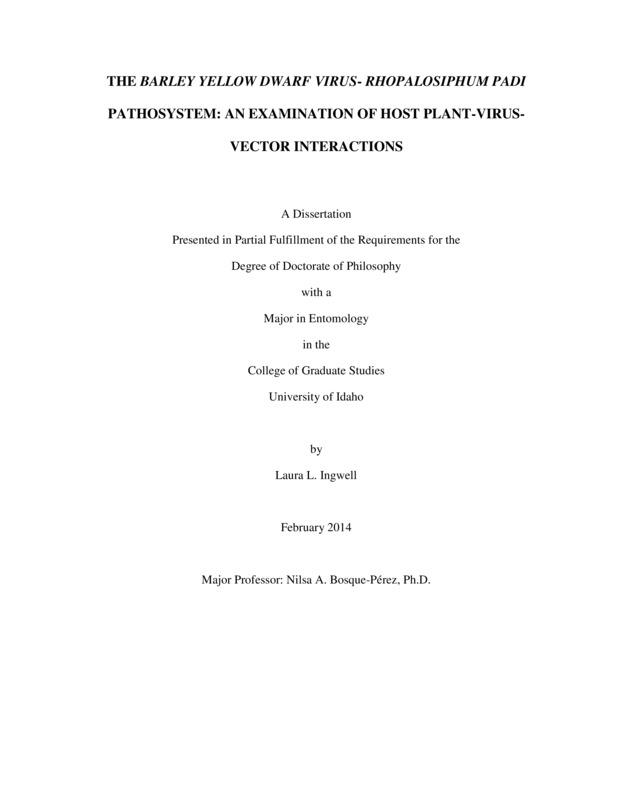The Barley yellow dwarf virus-Rhopalosiphum padi pathosystem: An examination of host plant-virus-vector interactions
Ingwell, Laura L.. (2014). The Barley yellow dwarf virus-Rhopalosiphum padi pathosystem: An examination of host plant-virus-vector interactions. Theses and Dissertations Collection, University of Idaho Library Digital Collections. https://www.lib.uidaho.edu/digital/etd/items/ingwell_idaho_0089e_10110.html
- Title:
- The Barley yellow dwarf virus-Rhopalosiphum padi pathosystem: An examination of host plant-virus-vector interactions
- Author:
- Ingwell, Laura L.
- Date:
- 2014
- Keywords:
- Insect Behavior Palouse Prairie Plant Virus Virus Ecology Virus Vector
- Program:
- Plant, Soil and Entomological Sciences
- Subject Category:
- Entomology; Ecology; Virology
- Abstract:
-
Barley yellow dwarf disease is an important plant disease caused by a complex of plant viruses referred to as
Barley/Cereal yellow dwarf virus (B/CYDV) which is comprised of eight viral species infecting cereal crops and over 150 otherPoaceae species. B/CYDV is transmitted exclusively by aphids in a persistent, circulative manner. In the United States, the most widespread species is BYDV-PAV transmitted byRhopalosiphum padi (L.).The effects of BYDV-PAV infection on host plant preferences were examined for viruliferous (virus-carrying) and nonviruliferous
R. padi . Viruliferous aphids that acquired virus from either infected barley or through membranes infused with artificial diet containing purified virus, were used to examine direct (membrane feeding) vs. indirect (infected host plant) effects of virus acquisition. Nonviruliferous aphids significantly preferred BYDV-infected plants while viruliferous aphids significantly preferred virus-free plants. The shift in preference from infected to noninfected plants following virus acquisition could accelerate the rate of virus spread and was shown to be the result of direct effects of virus acquisition within the insect vector.The wheat producing region of northern Idaho and eastern Washington is characterized by fragmented native prairie and Conservation Reserve Program (CRP) habitats embedded in an agricultural matrix. The Palouse Prairie and CRP lands were surveyed to determine in which habitats and grass species B/CYDV occur and what B/CYDV species are present. Ten species of
Poaceae that have not been reported as hosts of B/CYDVs were evaluated via laboratory inoculations. Nine of these species are found throughout the Pacific Northwest in Camas and Palouse Prairie habitats or CRP lands and one of these species is being proposed as a candidate for biofuel production.B/CYDV was found for the first time in Palouse Prairie and CRP habitats and BYDV-SGV and PAV were identified as the predominant viral species occurring in this region.
Achnatherum occidentale, A. lettermanii, A. thurberianum, Danthonia intermedia, Poa fendleriana, Sporobolus airoides, S. cryptandrus, Ventenata dubia andArundo donax were identified as new hosts of BYDV-PAV. Transmission of BYDV-PAV from some of these grass hosts to susceptible barley was demonstrated usingR. padi . The ecological and epidemiological implications are discussed. - Description:
- doctoral, Ph.D., Plant, Soil and Entomological Sciences -- University of Idaho - College of Graduate Studies, 2014
- Major Professor:
- Bosque-Pérez, Nilsa A
- Committee:
- Eigenbrode, Sanford D; Karasev, Alexander V; Prather, Timothy S; Zemetra, Robert
- Defense Date:
- 2014
- Identifier:
- Ingwell_idaho_0089E_10110
- Type:
- Text
- Format Original:
- Format:
- application/pdf
- Rights:
- In Copyright - Educational Use Permitted. For more information, please contact University of Idaho Library Special Collections and Archives Department at libspec@uidaho.edu.
- Standardized Rights:
- http://rightsstatements.org/vocab/InC-EDU/1.0/

